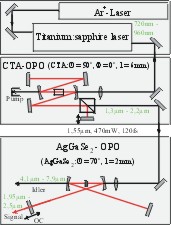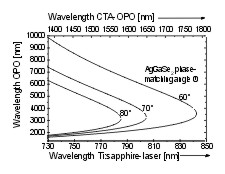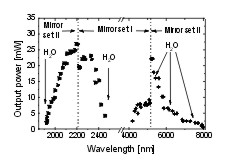|
|
|
|
|
© Stefan Marzenell |
|
The operation of a continuous-wave mode-locked silver gallium selenide (AgGaSe2) optical parametric oscillator (OPO) is reported. The OPO was synchronously excited by 120-fs-long pulses of 1.55 µm radiation at a repetition rate of 82 MHz. The 1.55 µm radiation is generated by a noncritically phasematched cesium-titanyl-arsenate (CTA)-OPO pumped by a mode-locked Ti:sapphire laser. |
|||||||||||
|
A schematic layout of the cascaded OPO-system is shown below. |
|||||||||||
 |
|||||||||||
|
A titanium sapphire laser (Spectra Physics Tsunami) generates 100-fs-long pulses around 780 nm with a repetition rate of 82 MHz and an average power of 1.7 W. This radiation is used to synchronously pump the CTA-OPO. The CTA crystal was 6 mm long and cut for type-II phasematching (eeo) with Q = 90° and F = 0°. The OPO is operated near the point of degeneracy. It is thus of advantage to distinguish between the o- and e-polarized wave instead of signal and idler wave. As the group velocity mismatch (GVM) between the o-polarized wave and pump wave is smaller than 25 fs/mm the duration of the generated o-polarized pulses is only slightly longer than the pump pulses. An interferometric autocorrelation of the o-polarized wave indicated chirp-free pulses with a duration of 120 fs. The generated average output power was 470 mW at 1.55 µm. This radiation was used to pump the AgGaSe2-OPO. |
|||||||||||
|
Tuning of the AgGaSe2-OPO can be accomplished either by using a fixed pump wavelength from the CTA-OPO and rotating the AgGaSe2 crystal, or by keeping a fixed crystal angle and changing the pump wavelength by changing the titanium:sapphire wavelength. This is illustrated below. |
|||||||||||
 |
|||||||||||
|
The solid lines are the phasematching curves calculated with the Sellmeier equations. If, for example, the wavelength of the CTA-OPO is changed between 1.49 µm and 1.6 µm a AgGaSe2 phasematching angle of 70° provides wavelengths between 2 µ and 2.5 µm for the signal wave and between 4.4 µm and 5.9 µm for the idler wave. With a fixed CTA wavelength of 1.55 µm a variation of the phasematching angle between 60° and 80° tunes the OPO wavelength in the range of 2 µm and 2.5 µm for the signal wave and 4 µm and 7 µm for the idler wave. It is of course possible to use a combination of these two techniques to choose almost any desirable combination of two wavelengths from the CTA-OPO and AgGaSe2-OPO. |
|||||||||||
 |
|||||||||||
|
The figure above shows the average output power of the signal and idler wave as a function of wavelength. The maximum average signal output power of 26 mW was measured at 2.2 µm. The idler power exceeded 22 mW at 5.25 µm. The idler wave is partly absorbed by CO2 at 4.25 µm and H2O vapor which has a broad absorption band that is centered at 6.27 µm. All these measurements were performed with a 2.0% output coupler in order to have low threshold power and small losses which allows for a large tuning range. With an output coupler with 7.2% transmission and a pump power inside the crystal of 403 mW an average output power of 67 mW and 35 mW was measured for the signal and idler wave, respectively. |
|||||||||||
|
To understand the processes that influence the pulse formation in the AgGaSe2-OPO, interferometric autocorrelations for all (pump, signal, and idler) waves were performed simultaneously to determine pulse length and pulse chirp. (see AC page) |
|||||||||||
|
The variation of pulse durations and chirp factors of signal and idler pulses can be explained in terms of a combination of self phase modulation, cross phase modulation, and chirp enhancement caused by a chirp of the pump pulse. For the claculation of self and cross phase modulation the nonlinear index of refraction of AgGaSe2 was measured using the Z-Scan method. |
|||||||||||
|
Further details are available at http://dx.doi.org/10.1007/s003409900188 |
|||||||||||
|
[Home] [Research] [Presentations] [Publications] [Links] [etc.] [Contact] |
|||||||||||